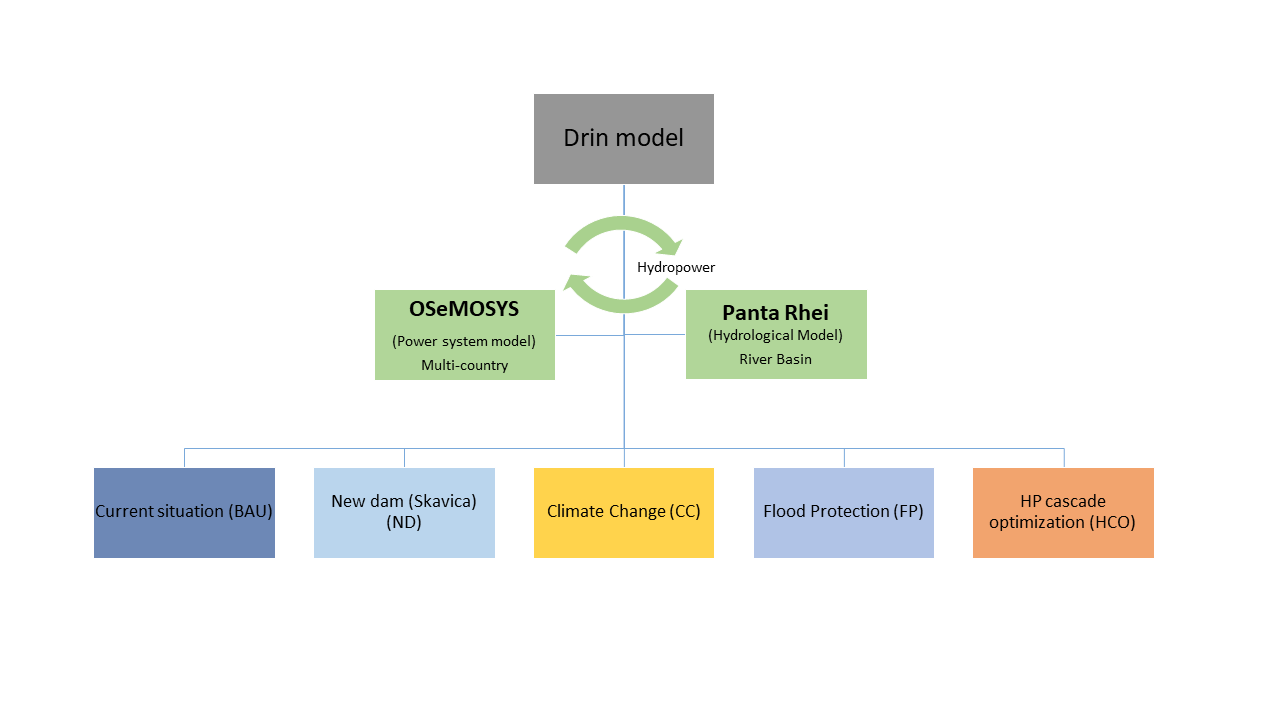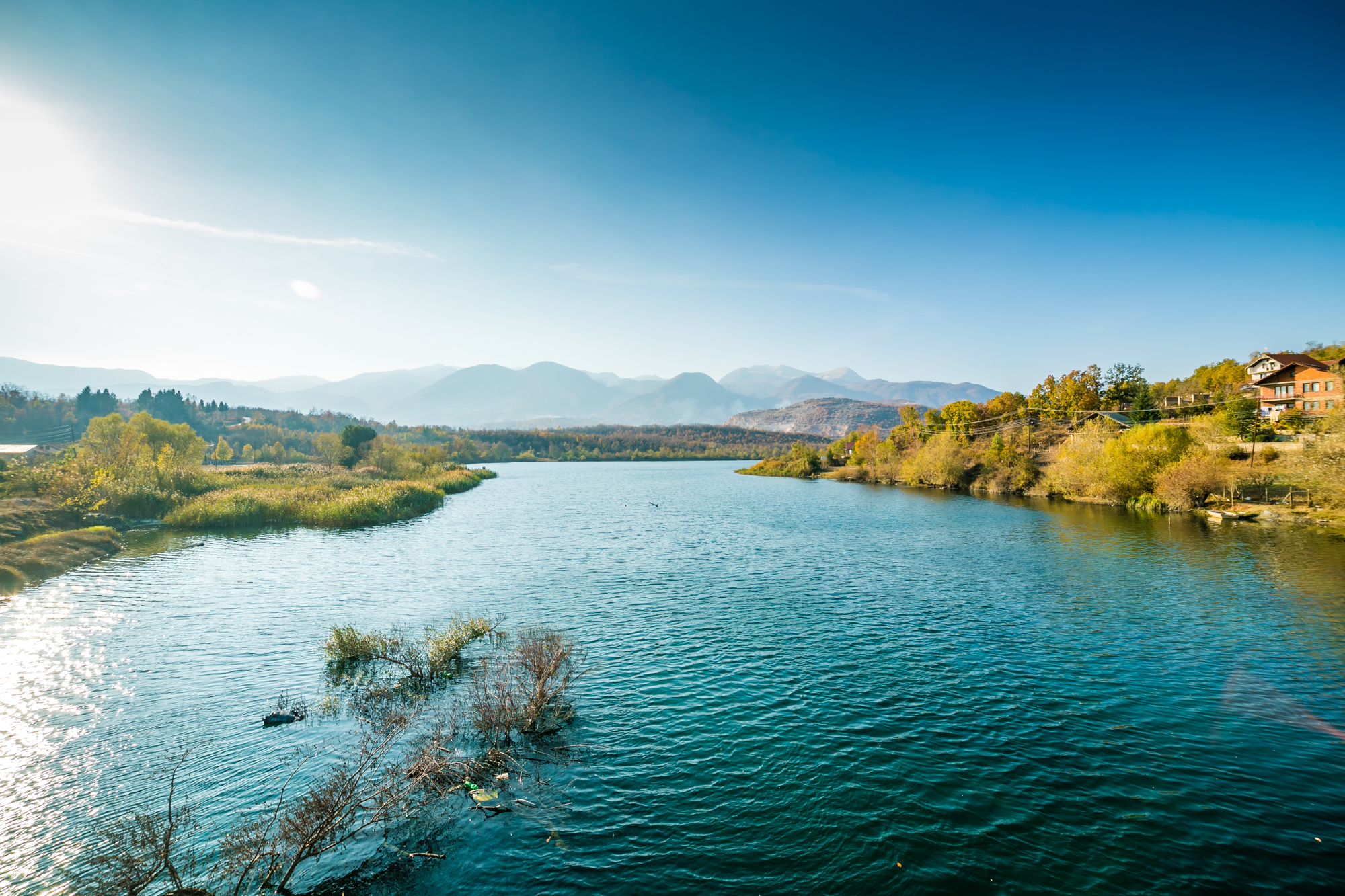Background
The Drin TDA was developed in 2018-19 in the context of the GEF/UNDP “Drin Project” implemented by GWP-Med. The TDA consisted of 6 Thematic Reports on socio-economics, biodiversity, hydrology, pollution, legal and institutional setting, and the Nexus. The Thematic Report on the Nexus (or Phase I Nexus Assessment) included a qualitative analysis of inter-sectoral dynamics, with emphasis on the potential of regional cooperation as a driver of positive change.
The Phase I Assessment showed that there are at least three areas where improving cross-sectoral governance could bring significant positive impacts for the basin, namely:
- Energy and water, because of the key role of hydropower operators in flow regulation and the management of floods and droughts;
- Energy, forestry, and water, to improve forest management in the basin and in turn better manage erosion and sedimentation, while upgrading the value chain of wood biomass;
- Agriculture and water, including irrigation practices, the selection of crops and the potential for trade.

At the recent Drin Stakeholder’s Conference in Tirana, Albania, Mr Tassos Krommydas, Senior Programme Officer, GWP-Med (pictured, right) led the session discussing issues to be explored in detail in the Phase II Nexus Assessment in the Drin basin and synergies and interlinkages with the Drin SAP, as well as further activities in the basin under the SEE Nexus Project funded by ADA and implemented by GWP-Med and UNECE.
The Phase II Nexus Assessment for the Drin river basin
Following up on the Thematic Report’s pointers for further analytical work that is needed to quantify the benefits of Nexus-related cooperation in the basin, a quantitative Phase II Nexus Assessment for the Drin river basin is now developed together with related activities under the SEE Nexus Project, funded by the Austrian Development Agency (ADA) and implemented by GWP-Med and UNECE.
The Nexus Assessment will focus on Hydropower and Floods and on Biomass and Sustainable Forest Management
The overall aim of the investigation on the Hydropower and Floods interface is to:
- Understand the potential impact on flood management of increased cooperation along and between the two hydropower cascades on the Drin;
- Quantify the costs and benefits of shifting to a “flood-smart”, cooperative hydropower operation regime in the basin;
- Identify the key changes in governance that are needed to allow for such a shift;
- Clarify the cost-effectiveness of new hydropower in the basin vis-a-vis the expected impacts of climate change and other renewable energy sources.
To serve this objective, an existing detailed hydrological model of the basin will be soft-linked with a multi-country power system model to be developed ad-hoc. The cascade of hydropower plants (HPPs) in the Drin (2 HPPs in North Macedonia and 3 HPPs in Albania) is the physical link between the two models.

The integrated water-energy model for the Drin river basin and the 5 key scenarios to be explored.
The integrated model will explore 5 key scenarios as well as combinations of them:
- Current situation (BAU).
- New dam (ND), reflecting the impact on power generation and flood control from the construction of the new HPP on the Drin in Skavica, Albania.
- Climate Change (CC), reflecting the implications of increased temperature and decreased precipitation.
- Flood protection (FP), to evaluate the implications on power generation under a scenario of HPP operation towards optimized flood management.
- HP Cascade Optimization (HCO), to evaluate the implications on flood risks under a scenario of HPP operation towards optimized power generation.
In order to provide meaningful insights to policy makers, the technical analysis of hydropower operation and cooperation in the Drin River Basin will be accompanied by a (simplified) evaluation of the socio-economic costs and benefits associated to the different scenarios, and also on the identification of clear responsibilities associated to water-energy cooperation at the level of governance and institutions to overcome the barriers to improved cooperation.
The overall aim of the investigation on sustainable biomass and forest management is to assess the economic, environmental, and social impact of upgrading and modernizing the wood biomass value chain in the framework of sustainable forest management, looking specifically into the benefits in terms of rural income diversification, improved health, climate mitigation, biodiversity protection, control of erosion, sediment control, gender equality and women empowerment.
To do so, the analysis will be based on a comprehensive review of related governance, markets, cross-sectoral policy framework, and consumption and trends.
The analysis will produce a map of cross-sectoral impacts, trade-offs and synergies related to the use of biomass and sustainable forest management across the water-food energy-ecosystems nexus and associate interlinkages to quantifiable key indicators which will support the identification of areas where further policy action is needed and some of them will help quantifying the economic, environmental and social benefits of sustainable biomass.
The analysis will also be used to suggest a package of solutions around Institutions, Information, Instruments, Infrastructure, International cooperation. The work hence supports and details further the actions in the SAP linked to the themes in focus.
Further Nexus activities in the Drin basin
Beyond the development of the Nexus Assessment, further Nexus-related activities will be implemented in the Drin River Basin under the ADA-funded Nexus Project:
- A Capacity Development workshop, lasting 2-3 days and engaging 20-25 targeted participants / staff of Nexus-related institutions from all 4 riparians will be held by the end of 2020, focusing on hands-on training in either integrated Energy-Water modelling, or integrated forest planning and management practices (the issue to be finalised soon in coordination with the riparians’ authorities)
- Project Documents / Investments fiches will be developed for two priority interventions addressing key Nexus-related interlinkages, based on the outcomes and suggestions of the Nexus Assessment Report. Developmental partners and International Financing Institutions will be invited to participate in the process. Indicative areas of intervention include the implementation of technical solutions, the development and implementation of management approaches, the enhancement of human and institutional capacities.
- A document of strategic guidance (“Nexus Roadmap”) assisting the implementation of the Drin SAP across sectors, from a Nexus perspective will be developed, identifying appropriate lines of action in order to ensure that the necessary cross-sectoral coordination is in place at institutional, policy and management levels, and to facilitate the mobilising of actions across sectors for the effective implementation of the SAP.
- A Gender Capacities development workshop will be implemented by the end of 2020, targeting 30 participants to be identified in coordination with riparians’ Nexus-related institutions and gender organisations. The objective of this workshop will be to introduce the dimensions of integrated natural resources management (NRM) to gender institutions and respectively to introduce the benefits of gender mainstreaming to institutions active in NRM in the basin, while increasing overall awareness and exchanging regional and international experience and best practices.
The SEE Nexus Project
The overall aim of the ADA-funded Project is to enhance integrated management of natural resources and transboundary cooperation in this regard, by introducing the Nexus approach and catalysing action for its adoption and implementation in the SEE2020 area, at the national and transboundary basin levels, thus assisting towards achieving the Nexus-related objectives of the Dimension “Environment” of the SEE2020 Strategy. In this context, Nexus Policy Dialogues will be implemented in Albania and in the Transboundary basins of the Drin and Drina rivers. These Dialogue processes comprise of inclusive consultation meetings and workshops, as well as of technical assessments and studies (Nexus Assessment conducted using the methodology developed under the UNECE Water Convention).
